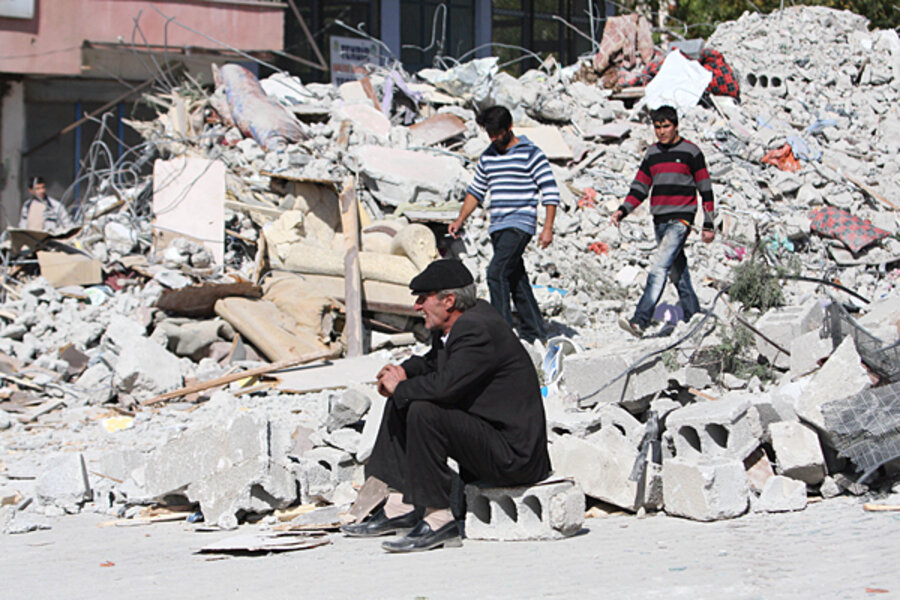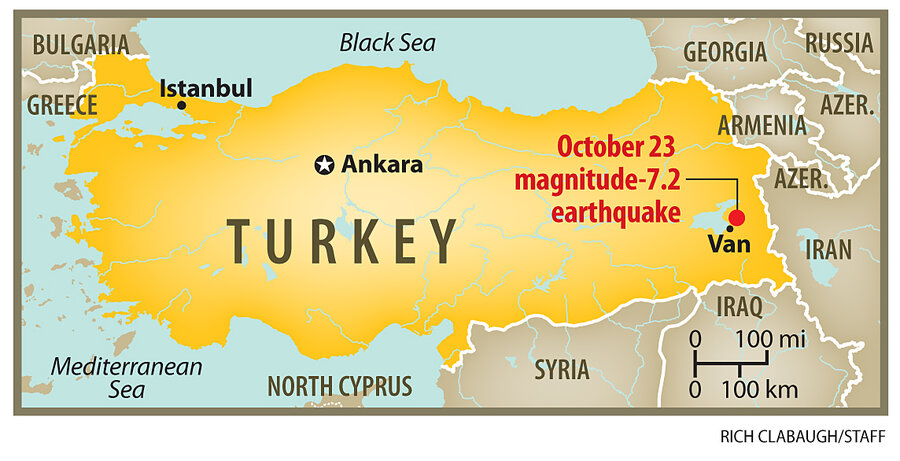Turkey earthquake: Digging out from quake, fears of more casualties
Loading...
| Ercis, Turkey
“No one has even touched this yet,” says Adem Yavuz Avci pointing at a two-storey building that has collapsed across the road entering his hometown of Ercis. “It was a hotel, we don't know how many people could be in there.”
This city of 75,000 people has borne the brunt of the 7.2 magnitude earthquake that rocked eastern Turkey on Sunday afternoon.
The official death toll so far stands at 279 people, with another 1,300 injured. But in Ercis, where 165 are confirmed dead, there is a widespread feeling that this figure only scratches the surface.
Entering the city, dozens of buildings - apartment blocks, hotels, markets – lie in heaps of rubble. Some lean at frightening angles, and here and there walls have fallen away, laying bare the homes within.
“It will take 30 years for our city to recover from this,” said Vedat Kanter, 35, a teacher left homeless after his apartment was severely damaged. “There must be 1,000 dead here alone, all we can do is pray to God.”
For a country crisscrossed with active faultlines and prone to frequent earthquakes, Turkey has in the past shown itself to be woefully unprepared for handling the devastation they cause.
But some say the country has come far since its last major earthquake, which killed 18,000 people when it struck the western city of Izmit in 1999.
Learning from tough experience
“I think that after the 1999 earthquake a cornerstone was set in terms of earthquake awareness in Turkey,” said Suleyman Nalbant, a geophysicist at the University of Ulster in Northern Ireland who studies Turkey’s seismology.
“Then the response was slow, communication was slow. It was a very important time and people didn’t know what to do.”
But since then Turkey has improved its emergency readiness, passed tougher building codes and strengthened its public infrastructure, he said.
“This time, all the government branches have reacted quite fast, charitable institutions have reacted as well.”
On the approach to Ercis today, a steady flow of military transports, cranes, ambulances, and trucks full of supplies could be seen heading to the city.
Turkey’s army has dispatched six battalions – which generally number between 500 and 1000 soldiers each, and a further 2,400 search and rescue personnel are in the disaster zone.
The Turkish Red Crescent sent some 7,500 tents, more than 22,000 blankets, almost 4,000 heaters, and other emergency supplies. But despite this response, many collapsed buildings appeared to be untouched by the emergency effort.
One young man said his 21-year-old cousin died after being trapped under concrete for more than 24 hours. Emergency services could not free him.
“It was just one hour ago,” he said. “We could see him and we could give him medicine, but we couldn’t save him. The people trying to save him were not professional enough,” he said.
Shoddy construction?
According to current official estimates, around 970 buildings have collapsed across the quake zone.
Despite the introduction of new building codes to address the country’s notoriously shoddy construction practices, some fear that enforcement has been insufficient.
A study by three universities conducted last year in Istanbul found that 42,500 of 146,987 buildings in six districts of the city surveyed were at risk, with 77 percent of all structures in two of the districts facing potential damage.
Seismologists predict the city is likely to face a major earthquake within the next 20 years, with one group of Japanese experts predicting that the death toll could rise as high as 40,000.
Meanwhile, a report by a Turkish parliamentary commission last year said the government was failing to reinforce substandard buildings, punish building code violators, and control urban development.
According to the University of Ulster's Nalbant, these problems may be acute in Turkey’s more impoverished eastern region, where the latest earthquake struck.
“The focus is still mainly on the Marmara region [around Istanbul],” he said. “Eastern Turkey sometimes escapes mention, and we should not forget that it is just as vulnerable.”
“Unfortunately the words of the law cannot be effective by themselves if the people enforcing them are not. Changing this mindset takes some time. Also, the building stock cannot be replaced in a short time.”
It is a view that Mr. Kanter, the teacher, agrees with. He had been showing his brothers around his newly-bought home when the earthquake struck. “The buildings aren’t strong enough.
“In Europe, they plan something first before they do it, here we do it first then think later.”
Though his apartment building did not collapse, and he and his brothers escaped unharmed, he fears it is too badly damaged to ever be habitable again.






